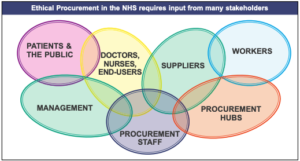Anyone in the health tech industry knows that the market is growing quickly. According to a recent study by Global Industry Analysts Inc, the global digital health industry is estimated to grow from US$152.5 Billion (2020) to $456.9 billion by 2026. This is exacerbated by the COVID-19 pandemic causing resource and staff shortages across the world. Now, more than ever, hospitals need to maximize efficiency and effectiveness.
With over 6,000 hospitals in the United States, especially many with a need for updated resources and data infrastructure, there is an expanding opportunity to provide care providers with high-quality health technology. With complicated hospital procurement procedures, how can you become a preferred vendor?
We’ve pulled together six key steps to streamline your sales process to hospitals and healthcare organizations:
- Do Your Research
- Develop a Prospect List
- Create Your Proposal
- It’s Time For The Demo
- Customer Education
- Closing The Deal: Prepare for a conversation with the CIO
1. Do Your Research
Like with any target market, the first step to successful sales to hospitals is a thorough and thoughtful research process. This will help your sales team analyze areas of need and ways to reach decision-makers, creating a customized, effective pitch process.
The People: Hospitals are complicated organizations with many moving parts, from management and administration to diagnostics and therapeutics. Keep in mind that the procurement process can take a long time as there are several groups that may have a stake in the decision.
Hospital decision-making stakeholders can include:
- Management/hospital administration
- Procurement staff
- Procurement hubs
- Workers
- Suppliers
- Therapeutic staff (doctors, nurses)
- Patients
- The public

Image from Green Hospital Procurement Policy and Procedure Manual
You’ll need to customize your pitch to the stakeholders that will be involved in your sales process. Be prepared to back up your product with a clear breakdown of costs, demonstrations, case studies, and testimonials. The more you know about your audience, the better.
Understanding the key decision stakeholders can also inform your plan for general brand awareness.
How can you tailor your case studies to their priorities?
How will you educate your customers about your product and how it works?
Pro tip: Building a “Customer Education” online course is a great way to educate your customers on your product and how they can best use it to their advantage to achieve their business goals. Learn more about building your Customer Education program here.
The Money: Another way to give your sales team the best chance at success is to determine the fiscal year-end for the hospitals you are targeting. In the United States, most receive public (Medicare, Medicaid) and private (health insurance) funding. Budgets for large items like equipment or software are set in advance of the next fiscal year, so it’s best to time your sales visits before those decisions are made and budgetary spending is accounted for.
The Numbers: Hospitals may exist for diagnosis, treatment, and education, but they are usually run like corporations. And like any business, hospitals have various metrics they use to determine success, allocate budgets, and make purchasing decisions.
- Structural measures evaluate a hospital’s systems and processes; their ability to provide care
- e.g. provider-to-patient ratio, ER wait time
- Process measures demonstrate data about a hospital’s medical care processes
- e.g. medical equipment utilization, bed occupancy rate
- Health outcomes indicate changes in patient health status
- e.g. patient mortality rate
The Process: Hospitals have a thorough vetting process for all new vendors. Look for hospital procurement guides and objectives which can tell you what qualities they need in a new partner. They may also have an extensive Request-for-Quotation (RFQ) process.
An example of a procurement policy is the Green Hospital Procurement Policy and Procedure Manual from The Canadian Coalition for Green Health Care. This document describes specifications for ideal environmentally-preferred medical equipment, the stakeholders that need to be involved in the decision-making process, and more.
2. Develop a Prospect List
As an established organization, you probably have a tried-and-true lead generation process. What’s unique about hospitals, however, is the often complex web of decision makers and stakeholders–the challenge is to find the right person (or people) to reach out to.
In larger organizations, the decision maker could be an internal manager or purchasing committee. Smaller hospitals or health-providing organizations generally belong to a group purchasing organization (GPO) where they can work together to buy in greater volumes and negotiate lower costs. There may also be region-specific groups that have influence over the organizations in their jurisdictions.
Because there are so many people involved in decision-making, you don’t have to aim for the highest levels of management when creating your prospect list. Don’t be afraid to cast your net widely!
3. Create Your Proposal
You’ve done your research, and you have a good list of prospects. Now it’s time to put together a great proposal for your sales representative. Whether it’s a traditional slide deck, video pitch, or something else, make sure that you front-load the benefits to the prospects. Hospital executives and decision makers are extremely busy people, and you want to grab their attention right away.
Start by defining your unique value proposition in terms of the values and metrics that hospitals use to measure success. If there’s a high switching cost for them to move to your product, be sure to differentiate from their current vendor. Include real cost analyses, describe the challenges your product will solve, and explain how you plan to integrate your product into their existing infrastructure.
When it comes to health tech, hospitals need to know that your product is safe, secure, and regulation-compliant. Be ready to answer questions about how you’re going to ensure patient confidentiality and mitigate data risks.
4. It’s time for the demo
Show your product in action. This is the step that will pull interested prospects into making a final decision–it’ll show them first-hand how much easier their jobs could be with your tech. With a good demo, they won’t be able to imagine operating without it.
Give them a guided walkthrough. Show them the highlights and features, emphasizing how they relate to their pain points and key metrics you identified during your research. If possible, set up a demo account so that your prospects can see your technology in action.
If you can, consider offering a free pilot or trial period so that hospital staff can give the technology a try. This will give you the chance to demonstrate your products and training, as well as your responsiveness to feedback. Providing training on your product through an online course will also shorten the process later on, once you’re ready to fully implement your product throughout the hospital.
Once you’ve had a few successful trial periods, use what you’ve learned to create a new and improved iteration of the product for future sales. Consider turning this process into a case study – it’ll lend credibility to your work and is a handy piece of content to send to prospects.
“Making training free is a big factor for many healthcare facilities that don’t have the capital to spend on education.”
– Christopher Caulfield, RN, NP-C – Co-Founder and Chief Nursing Officer, IntelyCare
5. Customer Education
Chances are, the healthcare institutions you’re talking to will need more than a great pitch and a successful demo. They’ll want to know that you’re a leader in the health tech industry and that your product comes with a wealth of knowledge, content, and education. In the fast-evolving area of health tech, hospitals need a way to stay up to date on the latest information and products. That’s where a learning management system like Thinkific Plus comes in.
At Thinkific, we see customer education as the process of enhancing your customers’ knowledge about your product or service to help them achieve value faster and better scale user growth. It’s the perfect way to equip your buyers with the information they need to experience value from your product and want to continue to use it.
In a hospital setting, there isn’t a lot of downtime for doctors or other staff to read long product manuals or attend half-day seminars. With Thinkific Plus, you can create a learning format that is accessible and scalable for every department, from quick video lessons to learn-as-you-go course modules.
The best part? Every step is customizable, so you can use your learning management system for every step of the sales funnel from leads to paying customers.
6. Closing the Deal
Once both sides are ready to sign on the dotted line, it’s time to have a conversation with the hospital’s Chief Information Officer (CIO). As the person responsible for all tech-related decisions and the handling of data within the hospital, the CIO has the final say (and veto power) on whether or not your product is the best option.
Finally, when the CIO is on board, have a senior-level manager in your organization reach out to negotiate the contract including an implementation and training plan.
Want to learn how Thinkific Plus can help your health tech organization create brand awareness, drive sales, and increase customer retention?
With Thinkific Plus, you can easily create accessible and scalable online programs for your customers to learn all about your product, from quick video lessons to learn-as-you-go course modules.
Thinkific Plus is a scalable platform that is simple to maintain, seamlessly integrates with your existing software, and is customizable for your brand needs.
Learn more about Thinkific Plus, and book a call with our solutions team to try it today.
Feeling curious?
- Check out how IntelyCare was able to award 200,000 COVID-19 nurse training certificates within 10 days.
- Or how the Mohammed Bin Rashid University of Medicine and Health Sciences took COVID-19 training viral with a community ambassador program that educated more than 940,000 people around the world.





